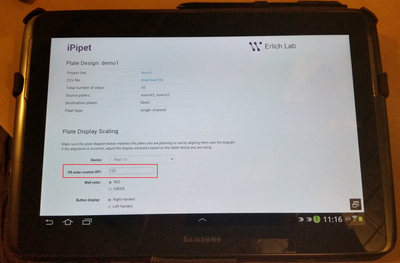|
Ask any of my friends or colleagues and everybody will testify: I'm a gadget freak. So when a twitter post mentioned something called iPipet, I just had to delve into it as the "i" sounded gadgety and the "pipet" referred to laboratory equipment. So, what's it about? iPipet is a new online software tool to help pipet samples from a source 96 or 384-wells plates into a destination plate. In many instances these are complex pipetting schemes and it's very easy to lose track. Let's say you want to pipet 5 microliter of your samples in columns 1, 3, 6, 9, 11, 12 into a new plate in columns 2, 5, 7, 9, 11, 12 respectively. If you lose track and pipet column 6 of the source plate not into column 7 as intended but in column 9 your whole scheme is ruined and you can throw away the destination plate with your partially pipetted samples. No fun! So, the authors Zielinski et al. came up with a ingenious solution: use your tablet as an illuminating pipetting tracker as described in this Nature Methods article. It works by showing two plates on your tablet screen, a source and a destination plate indicated by the white dots. The dots change to red or green (based on preference) to indicate which well should be pipetted from the source to the destination plate. Left on the screen it indicates the amount to pipet as well. On their website iPipet, you can find instruction on how to set-up the your pipetting scheme to use with the online software or you can use one of the already uploaded .csv files. It seemed as if the online software was only usable for iPads but you can set a custom DPI to match your own non-Apple tablet, which is great! In my case for the Samsung Galaxy Note 10.1 this is 149. The authors also provide a file to 3D print an adaptor for the (presumably) iPad to keep the plates from moving around on the screen as you pipet, but a little bit of double-sided tape will probably also work. Or you can make a custom adapter using cardboard and some tape. Anyway, I was positively surprised by this online software and next time I have to pipet complex schemes I will definitely use it. Source:
1 Comment
|
Archives
September 2018
Categories
All
|


 RSS Feed
RSS Feed






